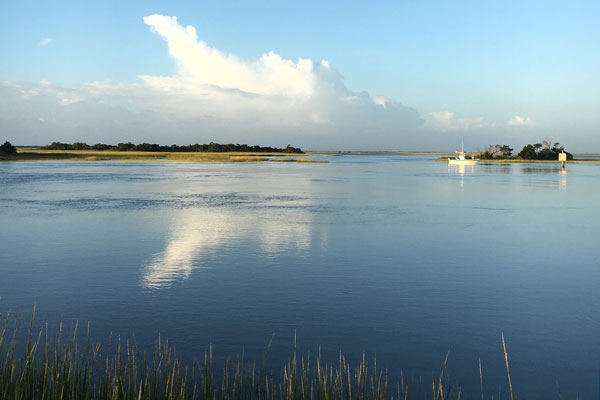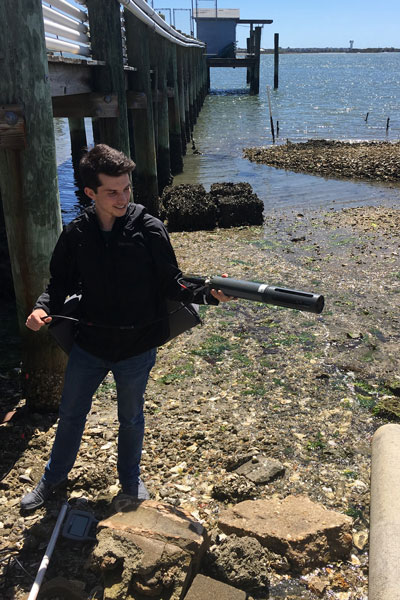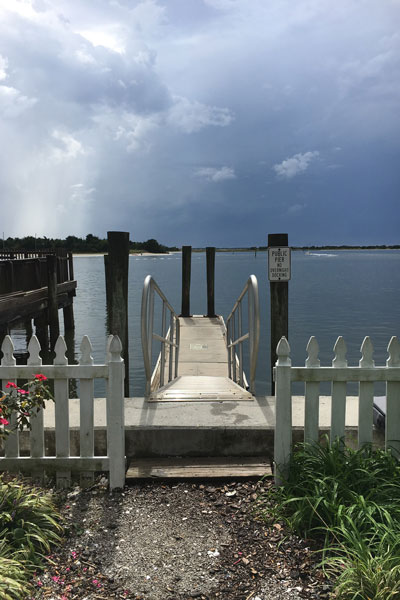
Photo: Researchers from the University of North Carolina at Chapel Hill’s Institute of Marine Sciences are working to understand and address the stormwater challenges facing a flat, coastal town like Beaufort. Photo by Justin Hart.
When I gather stormwater samples in and around Beaufort, I typically stand out.
I carry a large equipment bag and a pole. To an observer, I may look like a bargain Ghostbuster, a thought that only gets reinforced when I pull a vacuum-looking tube out of the equipment bag.
The pole allows me to place sample bottles in water near hard-to-reach pipes. The tube, called a sonde, enables me to gather simple information about the water like temperature and salinity. Together, my tools allow me to collect data about the water that people use for recreation and to harvest seafood.

The sonde, a vacuum-like tube, allows Justin Hart to collect environmental information. Photo courtesy Justin Hart.
Summer in North Carolina is a time for unpredictable rainstorms. The resulting stormwater picks up everything from spilled car oil to pet waste, carrying them to the nearest storm drain. These contaminants get washed into nearby bodies of water, where residents and visitors can come into contact with the pollutants and potentially become sick.
How might this affect people’s health? To find out, North Carolina Sea Grant provided funding for my advisor Rachel Noble, an environmental microbiologist at the University of North Carolina at Chapel Hill’s Institute of Marine Sciences, to study stormwater runoff to better protect human health at North Carolina public beaches. This project is part of a broader collaborative effort to understand and tackle the assortment of stormwater challenges facing a flat, coastal town like Beaufort.
Noble has worked with a variety of coastal towns in North Carolina, from Wrightsville Beach to Nags Head, on their stormwater issues. We also have received funding from the National Oceanic and Atmospheric Administration to gather local environmental groups, scientists and educators to look at how stormwater contamination affects the Rachel Carson Reserve.
For the Sea Grant study, I am focusing on the way stormwater carries and delivers fecal contamination. Feces carry more than just an ick factor — they also carry a variety of bacteria and viruses that are harmful to humans, some of them can cause serious illnesses. Yet, fecal contamination in water is not obvious. Even if the water doesn’t smell or have a weird color, the harmful microbes can still be there.
Swallowing the microbes in contaminated water is the main way of getting sick, but it is not the only pathway. After sticking your hand into the water while on a boat or splashing around in a puddle after a storm, these microbes can pass to your eyes, mouth and other parts of your body, where they can cause skin rashes, eye irritation, or vomiting, nausea and diarrhea.
In the past, researchers have found fecal contamination in Taylors Creek, where Beaufort’s pipes discharge stormwater. The town’s sewage and stormwater flow through separate pipes. As those pipes age, they are more likely to crack and leak. In some places, larger stormwater pipes encase smaller sewage pipes like a Russian nesting doll. If a sewer pipe cracks, sewage could leach into the stormwater and end up in Taylors Creek, or form puddles in the street above.
This problem is not unique to Beaufort. In fact, throughout coastal North Carolina, stormwater delivers more contamination than any other source. Through this project, we have the chance to practice techniques that can help us better understand and predict this pollution.
The town has a Stormwater Advisory Committee that addresses residents’ concerns and questions about stormwater. The committee members have a variety of skills and backgrounds related to stormwater management. Based on feedback from the residents and committee members, we chose sampling locations that made sense to the committee and community.

Beaufort’s stormwater pipes drain into Taylors Creek. Photo by Justin Hart.
Once I have my samples, the fun starts in the lab. We start by testing the samples for microbes that might indicate the presence of fecal matter. These microbes are types of bacteria found in the digestive tracts — and feces — of warm-blooded animals. When we find high concentrations, it suggests there is a problem, such as a leaky pipe, causing fecal contamination to be present in the recreational waters. While the concentration of these bacteria can give a sense of how much contamination there is, the results do not tell us if its source is humans or animals.
To do that, we look for the genetic fingerprint, or DNA signatures, of human-associated markers. If we have samples with high concentrations of fecal-indicator bacteria, but little or no human-associated DNA, we might look for DNA specific to bacteria from other animals, like gulls or dogs that also may cause the contamination.
The data help our collaborators at the Stormwater Advisory Committee decide how to reduce fecal contaminants and make the water around Beaufort safer. For example, if the source is human, the committee members might advise the town to look for leaky pipes. An animal-related source might cause members to focus on rules governing pet-waste disposal.
A stormwater system that pollutes less will mean the water near Beaufort stays safe for residents and visitors to enjoy. Such proactive protection of water quality will enable the town to promote development and tourism.
In the coming weeks, we will be working with the N.C. Division of Marine Fisheries and the town to test some of the sewer lines for leaks. If you see me collecting water samples this summer, stop for a chat. Folks tend to be curious about my appearance and the work I do.
More than anything, I hear from people that this research matters to them. They want to know that someone is interested and is looking into the connection between water and human health, even if they might not necessarily want to know exactly what is in the water they use.
The good news is that a lot of people are looking.
Justin Hart is working toward a master’s degree in environmental sciences and engineering at the University of North Carolina at Chapel Hill’s Institute of Marine Sciences. He researches the human-health risks of stormwater.